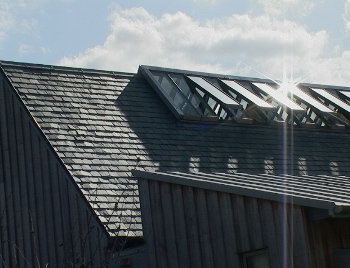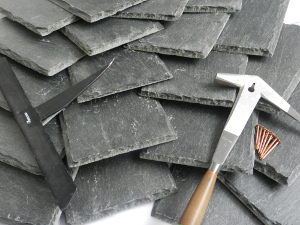A Brief History of Slate
Rock Classification
Rock is a natural, geologically-created material composed of minerals. ‘How’ a particular rock was formed leads to its classification which is generally either igneous, sedimentary or metamorphic: igneous rocks are formed when molten rock solidifies; sedimentary rocks form from grains of rock or organic matter deposited by wind or water and metamorphic rocks are either igneous or sedimentary rocks that have been transformed by heat and pressure within the Earth’s crust. Typical examples of rocks within these classifications are:
| Classification | Example |
|---|---|
| Igneous | granite, basalt |
| Sedimentary | mudstone, coal, limestone, sandstone |
| Metamorphic | marble, slate, phyllite |
SSQ quarries and markets slate and phyllite, two closely related rocks that are geologically defined as ‘foliated, regional metamorphic rocks created from fine-grained sediments’.
‘Third rock from the Sun’
The Earth was formed around 4,600 million years ago. As the embryonic planet cooled its surface hardened: it now comprises a relatively thin layer of solid rock (the crust) floating on a mass of molten and semi-molten rock (the mantle) surrounding a solid core.
The crust consists of about a dozen, quite separate, irregularly-shaped ‘plates’ that float on the mantle, constantly moving because of its powerful currents. This movement results in a number of ongoing, geophysical effects: the edges of some plates slip past each other horizontally; others collide, causing one to crumple to form mountains and the other to slide beneath it, back into the mantle where it will melt and be recycled; other plates are gradually moving apart, the resulting gaps being filled with new rock welling up from the mantle and solidifying.
The Earth’s cooling also caused water vapour in the atmosphere to condense into rain to create lakes, seas and oceans. The action of wind and water began to erode these first igneous rocks into grains which settled to form the first sedimentary rocks. The continual movement of the Earth’s crust gradually transformed some of these early igneous and sedimentary rocks into metamorphic rocks.
These continual geological processes happen on a timescale measured in hundreds of millions of years and the results are profound: they create the rocks we know today and shape the geography of our planet.
Timelines
The Earth was formed about 4,600 million years ago. The oldest rocks we know of are less than 4,000 million years old; the oldest rocks containing fossils are about 3,500 million years old. Just 200 million years ago, the Earth’s land masses had come together to form a vast supercontinent called Pangaea, the most recent in a series that have been formed and then broken up by plate movement: Pangaea’s break-up has resulted in the continents and oceans we recognise today. Dinosaurs became extinct 65 million years ago; the Himalayas started to form 35 million years ago (and are still growing) and modern humans appeared just 130,000 years ago.
Slate and Phyllite
The slate quarried today started to form during the Lower Palaeozoic era (a period of time defined as between 417 and 545 million years ago); phyllite is older and dates back to the Pre-Cambrian era (over 545 million years ago).
Slate is composed of fine grains of quartz and mica, either muscovite or illite, along with a range of other minerals that frequently include biotite, chlorite, hematite and pyrite. The exact mineral composition and their relative quantities affect the rock’s appearance, for example: chlorite gives slate a green colour; graphite – black; hematite – red and mica brings a silvery sheen. Phyllite’s composition is quartz, muscovite and chlorite: essentially it’s slate that has been subjected to a longer period of metamorphosis.
Slate was formed as a result of fine-grained, shale-type sediments being deposited deep on the ocean floor, the thick beds slowly compressing to form a layered sedimentary rock. This was eventually buried by movement in the Earth’s crust, the immense heat and pressure gradually transforming it into harder, stronger metamorphic rock.
This burial process often takes place in areas where neighbouring plates collide and are sometimes referred to as ‘Slate Belts’. A typical example is that covering north Wales, Cumbria, southern Scotland and Northern Ireland and marks part of the area where Laurentia (the plate containing Scotland and North America) collided with Baltica (Scandinavia) between 400 and 600 million years ago.
Mineral inclusions and pyrite
Most rocks contain ‘inclusions’ (a body or particle of another substance embedded in their structure), some are reactive, others are stable. The most potentially damaging inclusion in slate is pyrite, a shiny yellow crystal of iron disulphide (FeS2) formed from particles of organic material present in the sedimentary muds and crystallised during the rock’s metamorphic processing.
The presence of pyrite in a slate can be potentially disastrous. When exposed to water vapour in the air iron disulphide reacts, decomposing to form powdery iron sulphate and sulphuric acid. How quickly this happens, and its effect on the slate, varies:
- It may just cause a stain around the inclusion
- It may leave an unsightly, rust-coloured ‘run’ on both the slate and those in lower courses
- Its decomposition will leave anything from just a pit in the surface to a hole through the slate
- The slate may delaminate and split, or even totally disintegrate
The Thermal Cycling Test specified by EN 12326 tries to predict the effect of pyrite in the slate and offers three classifications:
T1 means there may be some discolouration around the pyrite itself, but the structure will not be affected
T2 means that although the pyrite will leach to form unsightly runs of discolouration, structural changes are unlikely
T3 means that holes may form as a result of the pyrite decomposing
Beyond this, if exfoliation, splitting or other structural changes occur, the roofing slates being tested are considered unacceptable for use.
It must be stressed that not all inclusions are either pyrite or reactive: many are inert and may do nothing other than perhaps give the slate a ‘sparkly’ appearance. But if inclusions are present it’s vital to look at the test data accompanying the slates and check the result of the Thermal Cycling Test.
Generally, if an inclusion is ‘cubic’ and is tightly formed with ‘neat’ edges, it’s probably inert and stable.
However, the only way to confirm this is by looking at the result of the Thermal Cycling Test in the slate’s test report – this will grade the level of risk as being either T1, T2 or T3.
The effect of a pyrite dissolving and leaching to cause runs of discolouration on a roof.
The stain is permanent and cannot be removed. The slates affected will have to be removed and replaced to prevent further contamination and ensure the roof maintains its watertight integrity.
A close-up showing how a pyrite has oxidised and spread within the slate’s structure. The weakness may result in a hole or delamination.

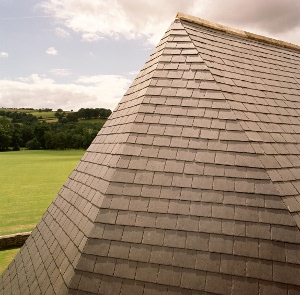
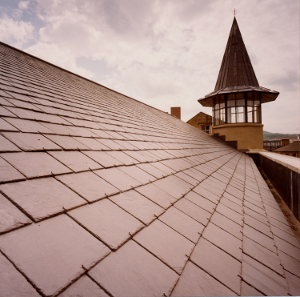 It’s difficult for any other material to compete with natural slate. The durability of a literally ‘rock hard’ natural material means that a quality slate roof will last a lifetime (or two), while the man-made alternatives need to be replaced once, twice or even three times over the course of the building’s lifetime.
It’s difficult for any other material to compete with natural slate. The durability of a literally ‘rock hard’ natural material means that a quality slate roof will last a lifetime (or two), while the man-made alternatives need to be replaced once, twice or even three times over the course of the building’s lifetime.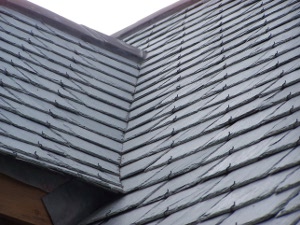 Like natural slate, clay tiles come in a variety of colours and qualities. Its short-term cost varies considerably, but overall it is similarly priced to slate. In terms of its environmental impact, however, the production of clay tiles is far more damaging to our world. The production of clay is kiln fired and during this vitrification process more energy is expended and carbon dioxide released, relative to the Natural Slate production process.
Like natural slate, clay tiles come in a variety of colours and qualities. Its short-term cost varies considerably, but overall it is similarly priced to slate. In terms of its environmental impact, however, the production of clay tiles is far more damaging to our world. The production of clay is kiln fired and during this vitrification process more energy is expended and carbon dioxide released, relative to the Natural Slate production process.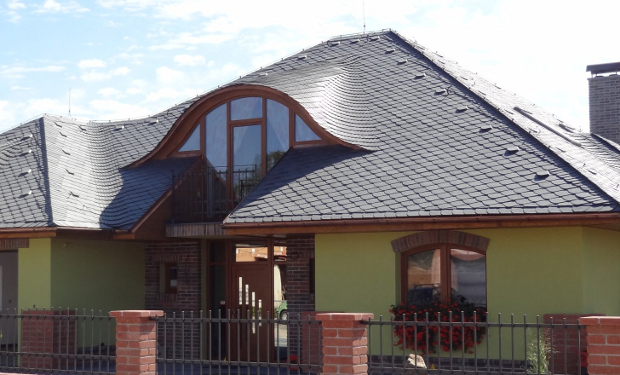 There’s a reason thousands of architects, hundreds of roofers and countless homeowners across the world choose to rely on SSQ for a beautiful, quality roof.
There’s a reason thousands of architects, hundreds of roofers and countless homeowners across the world choose to rely on SSQ for a beautiful, quality roof.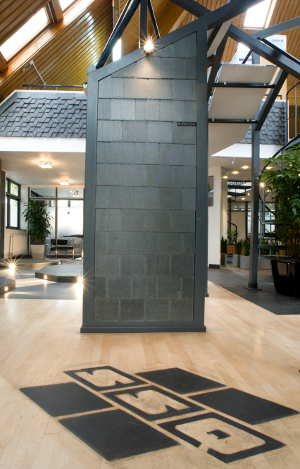 Driven by a belief in the beauty and effectiveness of high quality slate, and a passion for a level of service that makes the rest of the industry take a long, hard look at itself, our chairman forged ahead and built SSQ as the first company to import quality slates into the UK market.
Driven by a belief in the beauty and effectiveness of high quality slate, and a passion for a level of service that makes the rest of the industry take a long, hard look at itself, our chairman forged ahead and built SSQ as the first company to import quality slates into the UK market.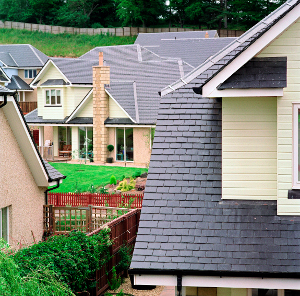 You’re a busy person. You’ve got people to see, places to be, and multiple projects on the go. You can’t be sitting around worried about the state for your roof all day long.
You’re a busy person. You’ve got people to see, places to be, and multiple projects on the go. You can’t be sitting around worried about the state for your roof all day long.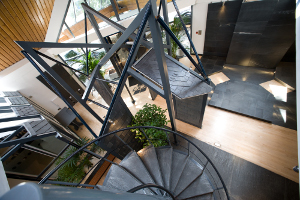 OK so hopefully by now you know we put our customers first when it comes to service. So how about the performance of the slate products we sell? Simply put, our slates are tested to the highest standards in the industry, so you can rest assured your roof will last:
OK so hopefully by now you know we put our customers first when it comes to service. So how about the performance of the slate products we sell? Simply put, our slates are tested to the highest standards in the industry, so you can rest assured your roof will last: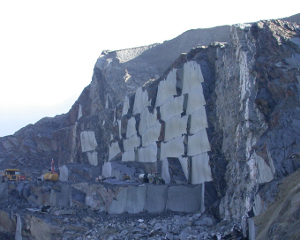 Last but not least, we know that traceability of slates and quality control are seriously important issues. That’s why you need to know where your slate is coming from and whether they have been quality-controlled at source.
Last but not least, we know that traceability of slates and quality control are seriously important issues. That’s why you need to know where your slate is coming from and whether they have been quality-controlled at source.